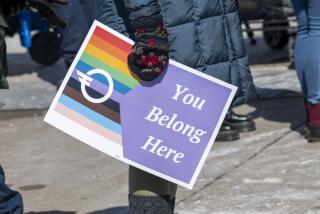Traveling Exhibition Attests to Christianity in China
About 14 million Christian Bibles have been printed in China since the end of the Cultural Revolution 25 years ago.
Last week an unusual exhibition unveiled at Garden Grove’s Crystal Cathedral told much of the story leading up to that accomplishment.
For the record:
12:00 a.m. May 14, 2006 For The Record
Los Angeles Times Sunday May 14, 2006 Home Edition Main News Part A Page 2 National Desk 1 inches; 40 words Type of Material: Correction
Bibles printed in China: An article in the May 6 California section said about 14 million Christian Bibles had been printed in China since the end of the Cultural Revolution 25 years ago. The actual number is about 40 million.
“We want to let the people of the U.S. know that there are real Christians in China,” said the Rev. Cao Shengje, president of the Shanghai-based China Christian Council, which sponsored the exhibition.
The first exhibition of its kind outside China, the show covered six galleries in the cathedral’s arboretum with more than 50 items related to the history of Christianity in China, including an “imperial edition” of the Bible published in 1894 and presented by a group of Christian women to the Empress Dowager Cixi of the Qing Dynasty. Among other notable objects: a 65-foot calligraphy scroll called the “Song of Songs.”
“I love you very, very deeply,” the Rev. Robert H. Schuller, the cathedral’s founder, told the gathering of Chinese dignitaries and visitors at the show’s opening April 21.
“I think that China is going to change the world because Christ is going to be known and spread through you,” he said.
The Garden Grove exhibition closed April 28 and is scheduled to move to Atlanta for an engagement this month and to New York City in June.
Although the first Christian Bible entered China about the year 635, experts said, it took centuries for its ideas to spread. During the Cultural Revolution of the 1960s, according to Shengje, the Bible was banned and almost all copies of it burned.
Since then, Shengje said, the Chinese government has eased its restrictions on religious practices in the country, allowing new Bibles to be printed and even endorsing exhibitions such as the current one.
Today, Shengje said, there are about 16 million practicing Christians in China -- a small percentage of the population “but growing very quickly.”
An All-Faiths Center
USC, one the nation’s most religiously diverse campuses, plans to build a multi-faith center -- a gathering place for students of different faiths, as well as those who see themselves as spiritual but not religious.
Planners picture a “kaleidoscope of activities” at the Multi-Faith Center for Research, Reflection and Practice.
As Rabbi Susan Laemmle, dean of religious life, envisions it, the center will enable students of “any background” to join Muslim students breaking the fast during Ramadan, or Christians observing Ash Wednesday, or Jews welcoming the Sabbath.
Plans call for a spacious interfaith hall, a library, counseling rooms, a dining space, Muslim prayer site with a nook for ceremonial washing, meditation spot for Buddhists, Hindu prayer space, including an altar, and an outdoor garden for prayer and reflection.
USC’s existing Center for Religion and Civic Culture and Office of Religious Life would move to the center.
“Our contemporary world is highly polarized, with religion being a primary expression and cause,” said Donald E. Miller, executive director of the Center for Religion and Civic Culture. “At USC, we have a unique opportunity to build bridges and forge connections,” he said, noting that more than 100 faculty members in various disciplines are involved in some type of research or teaching related to religion.
During their college years, students inevitably ask where truth lies, question values they grew up with and explore other faiths and nonfaiths, said Miller, a specialist on the sociology of religion. “All of that is going to be welcome in the new facility.”
Laemmle said the center would cost “at least $20 million” and that fundraising would begin soon. A site for the center has not been chosen.
A Dip in Donations
Years of sex abuse scandals in the Roman Catholic Church didn’t keep many parishioners from going to church, but that didn’t mean their wallets followed, according to a study released Wednesday by the Center for Applied Research in the Apostolate.
Ten phone polls, seven of them partly funded by the U.S. Conference of Catholic Bishops, show little difference in church attendance from 2001 to 2005. Accusations of sex abuse within the church began attracting national coverage in March 2002.
But the percentage of participants who regularly donated money to their local parish gradually fell from 78% in January 2001 to 72% in October 2004, though donations saw a slight rise in October 2005 to 74%.
A third of participants between 2001 and 2002 said the sexual abuse scandals were the reason they donated less.
The sample size of the polls varied. Researchers contacted about 1,200 self-identified Catholics nationwide in most of the surveys.
A Steward of Scholars
A Claremont professor will become executive director of the world’s largest association of religion scholars in July.
The American Academy of Religion, made up of 10,000 scholars around the world, announced in April that Jack Fitzmier, a religion professor at the Claremont School of Theology and Claremont Graduate University, will take the post.
“I am deeply honored to have been elected to this position, particularly in an era such as ours, when the need to understand religion has become increasingly important,” Fitzmier said. “I have to carry on the terrific growth and development of the academy.”
Founded almost 100 years ago, the group publishes a quarterly journal that is considered among the top academic journals of religious studies.
Low Opinion of Atheists
U.S. parents would rather their child marry a Muslim than settle down with an atheist, according to a recent study by the University of Minnesota.
The survey of 2,081 people nationwide revealed that atheists top a list of groups that Americans find “problematic in both public and private life.”
Researchers gave participants a list of groups -- including conservative Christians, gays and lesbians, and recent immigrants -- and asked them which groups related to their “vision of America.”
Atheists were chosen the least, with about 40% of participants responding that atheists “do not at all agree with my vision of American society.”
Respondents were also asked about potential spouses for their children, and atheists brought up the rear again. About 48% said they would disapprove of their child marrying one.
Muslims were the second least-favorable suitors, with about 34% of respondents saying they’d disapprove.
Atheists account for about 3% of the U.S. population.
*
Times staff writer K. Connie Kang contributed to this story.
More to Read
The biggest entertainment stories
Get our big stories about Hollywood, film, television, music, arts, culture and more right in your inbox as soon as they publish.
You may occasionally receive promotional content from the Los Angeles Times.










